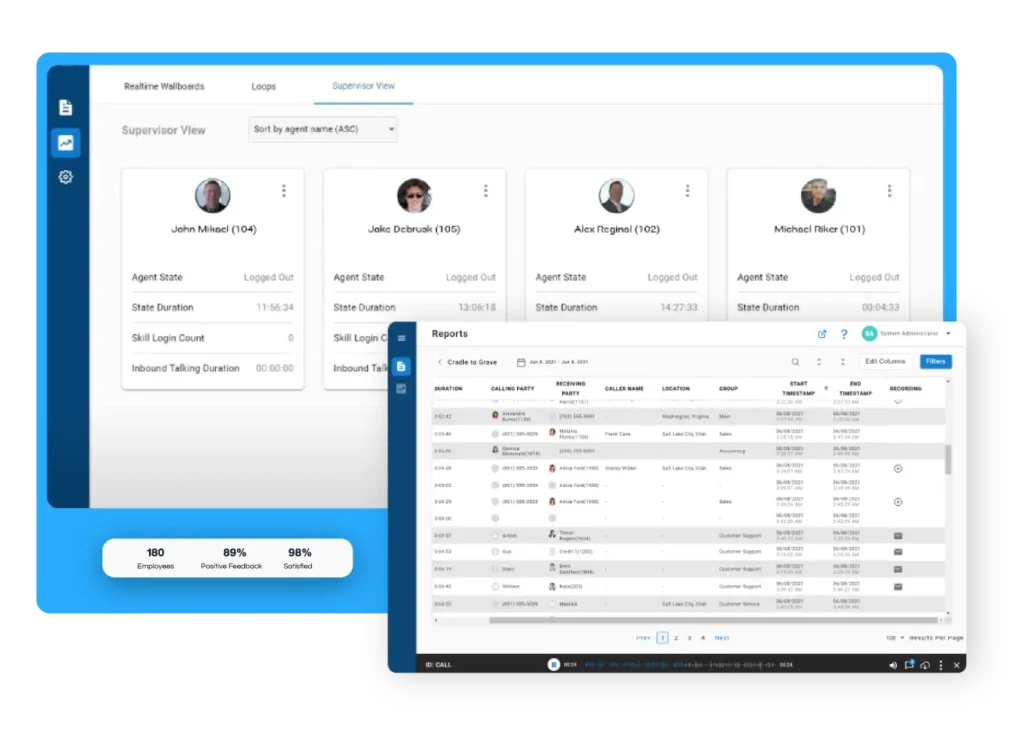Predictive AI in Finance: Helping Before Members Reach Out
How Financial Institutions Build Loyalty Through Proactive Support
In today’s competitive business landscape, delivering a superior customer experience (CX) is no longer optional–it’s a necessity. Businesses that prioritize CX don’t just retain more customers; they also drive higher revenue, build stronger brand loyalty, and gain a significant competitive edge.
The shift from product-centric to customer-centric strategies has made understanding and improving CX a top priority. But how do you measure something as complex as customer experience? Without the right data, businesses risk making decisions based on assumptions rather than insights.
This guide will walk you through how to measure customer experience effectively. By leveraging data-driven insights, you can fine-tune your approach, enhance customer interactions, and ultimately drive long-term success.
Measuring customer experience is crucial because it directly impacts business success. A positive CX fosters loyalty, strengthens brand reputation, and drives revenue growth. Companies that effectively track and analyze CX can make data-driven improvements that enhance customer satisfaction and long-term engagement.
Understanding CX through measurable insights helps businesses retain more customers. Satisfied customers are not only more likely to make repeat purchases but also become brand advocates, spreading positive word-of-mouth and improving overall brand perception. Conversely, identifying areas where customers face friction allows companies to refine their approach and eliminate pain points that could lead to dissatisfaction.
Measuring CX helps businesses maintain a competitive advantage. In a crowded market, companies that prioritize customer experience stand out by delivering seamless, personalized interactions. Tracking and optimizing CX metrics can reduce churn, boost customer retention, and position a brand as a leader in its industry.
A CX measurement framework provides a structured approach to understanding and improving customer interactions. One essential component is customer journey mapping, which outlines every touchpoint a customer encounters-from initial awareness to post-purchase support. Mapping these interactions helps businesses identify friction points, streamline processes, and enhance the overall experience.
Equally important is aligning CX goals with broader business objectives. Whether the focus is on boosting retention, increasing Net Promoter Score (NPS), or optimizing customer service efficiency, CX measurement should directly support a company’s strategic priorities. A balanced approach to CX tracking includes both quantitative data, such as CSAT and CES scores, and qualitative insights from surveys and customer feedback. Combining these perspectives provides a comprehensive view of customer satisfaction and areas for improvement. For further insights into data-driven CX strategies, check out our guide on why contact center reporting is crucial for business success.

To effectively measure customer experience, businesses rely on specific metrics that provide insights into customer satisfaction, loyalty, and overall engagement. These metrics help organizations understand how well they are meeting customer expectations and where improvements are needed.
CSAT is a widely used metric that measures customer satisfaction with a specific interaction, product, or service. It is typically gathered through post-interaction surveys, where customers rate their satisfaction on a scale (e.g., 1 to 5 or 1 to 10). High CSAT scores indicate that customers are happy with their experience, while low scores highlight areas that require improvement. By tracking CSAT over time, businesses can identify trends and take proactive steps to enhance customer satisfaction.
Net Promoter Score (NPS) is a widely used metric to measure customer advocacy and loyalty. It is calculated by asking customers a simple question: “On a scale of 0-10, how likely are you to recommend our product/service to a friend or colleague?” Based on their response, customers are grouped into three categories: promoters (9-10), passives (7-8), and detractors (0-6).
The NPS score is then calculated by subtracting the percentage of detractors from the percentage of promoters. This results in a score ranging from -100 to +100. A higher NPS indicates stronger customer loyalty, suggesting that a larger proportion of customers are willing to advocate for the brand. NPS is an invaluable tool for businesses looking to understand customer sentiment, gauge satisfaction, and ultimately improve loyalty by addressing concerns of detractors.
Customer Effort Score (CES) measures how easy or difficult it is for customers to interact with a business, whether it’s resolving an issue, making a purchase, or finding information. Customers are typically asked to rate their experience on a scale–such as from “very easily” to “very difficult”- after completing a specific interaction.
A lower effort score indicates a smoother customer experience, which directly correlates with higher satisfaction and loyalty. Businesses use CES to identify friction points in their processes and make improvements that reduce frustration. Since ease of interaction is a key driver of customer retention, tracking CES helps organizations refine their customer journey, ensuring that support systems, self-service options, and purchasing pathways are as seamless as possible.
First Response Time (FRT) measures how quickly a company acknowledges a customer inquiry, while Average Resolution Time (ART) tracks the total time it takes to fully resolve an issue. These two metrics are critical indicators of a company’s responsiveness and efficiency in handling customer concerns.
A fast First Response Time reassures customers that their issues are being addressed, reducing frustration and increasing trust in the brand. Meanwhile, a lower Average Resolution Time signifies a well-optimized support system that swiftly resolved problems. Businesses that consistently improve these metrics enhance customer satisfaction, reduce churn, and build stronger brand loyalty by demonstrating reliability and commitment to customer care.
First Contact Resolution (FCR) measures the percentage of customer issues resolved during the first interaction, without requiring follow-ups. A high FCR rate indicates that a company’s support team is well-equipped to address customer needs efficiently, leading to higher satisfaction and reduced operational costs.
Improving FCR not only enhances the customer experience but also boosts support team productivity by minimizing repeated interactions. Businesses can optimize their FCR by implementing skills-based routing, ensuring that customer inquiries are directed to the most qualified agents from the start. Learn more about this approach in our guide on skills-based routing.
Effectively measuring and improving customer experience requires a data-driven approach. By leveraging advanced tools like reporting, analytics, and skills-based routing, businesses can gain deeper insights into customer interactions and streamline their support processes. Xima Software offers comprehensive CX solutions that help organizations track key metrics, uncover trends, and make informed decisions to enhance customer satisfaction.
To improve customer experience, businesses must go beyond raw data and uncover meaningful patterns. Analyzing CX metrics over time helps identify trends, such as recurring pain points or opportunities for engagement. Segmenting data—by customer demographics, service interactions, or purchasing behavior—provides a more granular understanding of customer needs and preferences.
Transforming data into actionable insights is crucial for strategic decision-making. Businesses can use reporting and analytics tools to extract valuable insights and refine their CX strategies. Learn more about how Xima Software supports this process with its reporting and analytics solutions.
A data-driven CX strategy is only effective when supported by a customer-centric company culture. Engaged employees play a vital role in delivering outstanding customer experiences. Organizations that prioritize customer-centric training and initiatives empower their teams to make proactive, customer-first decisions.
By fostering a culture where employees feel ownership over CX, businesses can ensure that every interaction contributes to a positive experience. Discover how Xima Software enables businesses to create customer-centric service and support through its tailored solutions: customer-centric service support.
Customer experience is not a one-time effort—it requires ongoing refinement. Regularly monitoring CX metrics allows businesses to spot shifts in customer expectations and adjust their strategies accordingly. Implementing A/B testing helps organizations experiment with different approaches and identify the most effective solutions for enhancing CX.
Feedback loops are essential for continuous improvement. By collecting and acting on customer feedback, businesses can proactively address concerns, enhance service quality, and maintain long-term customer satisfaction.
Measuring customer experience is essential for driving business success. By tracking key metrics–such as NPS, CSAT, CES, and response times–companies can gain valuable insights into customer satisfaction, identify areas for improvement, and create a competitive edge. A data-driven approach ensures that businesses can continuously refine their strategies, enhance service delivery, and foster long-term customer loyalty.
Now is the time to take action. Implementing a structured CX measurement framework and leveraging powerful analytics tools can transform the way your business interacts with customers. Xima Software provides advanced CX reporting, analytics, and skills-based routing solutions to help you streamline the process and make data-backed decisions with confidence.
Ready to elevate your customer experience strategy? Book a demo today and discover how easy it is to measure, analyze, and optimize CX.
How Financial Institutions Build Loyalty Through Proactive Support
Call centers generate vast amounts of data every day. From call volume to agent performance, this information can quickly become overwhelming without the right tools.
Join us for an exclusive webinar as we dive into our latest product releases for IVR, MMS Messaging, and our Social Media Integration.

Thursday, September 12, 2024 | 11:00AM ET